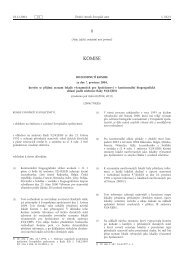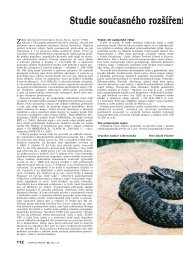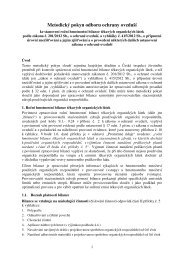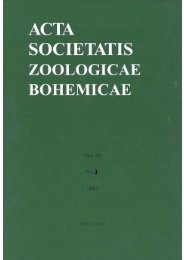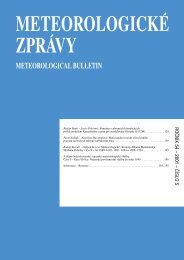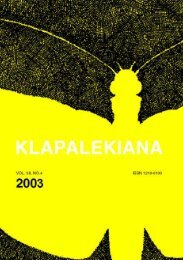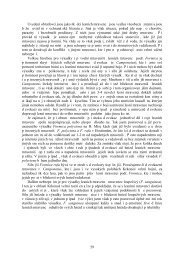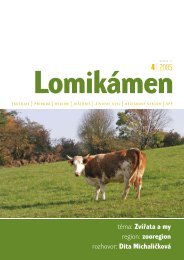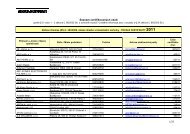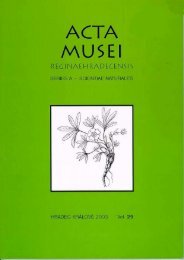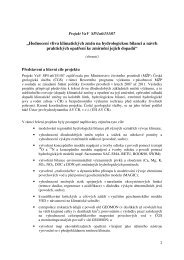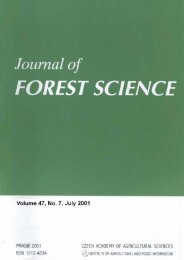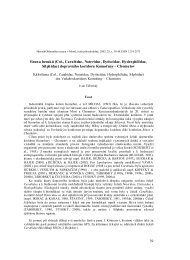Distribution and taxonomy of some Synapsis species, with ...
Distribution and taxonomy of some Synapsis species, with ...
Distribution and taxonomy of some Synapsis species, with ...
Create successful ePaper yourself
Turn your PDF publications into a flip-book with our unique Google optimized e-Paper software.
according to personal communication from R. Fabbri <strong>and</strong> G. Burgio (curator <strong>of</strong> entomology at<br />
IEUS), no type specimen(s) <strong>of</strong> S. tyrolensis pennina were found in coll. G. Leoni, deposited in<br />
IEUS. In my opinion, differences given by Depoli (1931) concern only individual variation <strong>with</strong>in S.<br />
tyrolensis.<br />
Portevin (1943) described Silpha tyrolensis var. pyrenaica from Basses-Pyrénées: Iraty. His<br />
description is based on a single, large specimen, wider <strong>and</strong> more vaulted than the nominotypical<br />
form, <strong>with</strong> finer punctation on pronotum. In my opinion, the holotype I studied is wider <strong>and</strong> more<br />
vaulted, but falls <strong>with</strong>in individual variability <strong>of</strong> S. tyrolensis. Its pronotal punctation does not<br />
differ from that <strong>of</strong> other specimens <strong>of</strong> S. tyrolensis in MNHN.<br />
Consequently, I consider Silpha tyrolensis var. externa Portevin, 1926, Silpha tyrolensis cottia<br />
Depoli, 1931, Silpha tyrolensis pennina Depoli, 1931 <strong>and</strong> Silpha tyrolensis var. pyrenaica Portevin,<br />
1943 as junior subjective synonyms <strong>of</strong> Silpha tyrolensis Laicharting, 1781.<br />
316<br />
Thanatophilus rugosus (Linnaeus, 1758)<br />
Silpha rugosa Linnaeus, 1758: 361.<br />
Thanatophilus rugosus tuberculatus Depoli, 1931: 13; syn. n.<br />
Thanatophilus rubripes Portevin, 1943: 47; syn. n.<br />
TYPE MATERIAL EXAMINED. LT female <strong>of</strong> Thanatophilus rugosus tuberculatus (IEUS; here designated), labelled “ITA-<br />
LIA [p] / Calabria [hw] / G. Leoni [p] // Thanatophilus / rugosus / tuberculosus [hw, Depoli’s MS] / G. Depoli det.<br />
[p] // LECTOTYPE (female symbol) / Thanatophilus rugosus / tuberculosus Depoli, 1931 / Jan R%ži!ka design.<br />
2002 [p, red label] // Thanatophilus / rugosus / (Linnaeus, 1758) / Jan R%ži!ka det. 2002 [p]”.<br />
LT female <strong>of</strong> Thanatophilus rubripes (MNHN, coll. generale; here designated), labelled “Minchow / China [p]<br />
// T. rubripes / type m. [hw, Portevin’s MS] // TYPE [p, red label] // MUSÉUM PARIS [p, yellow label] //<br />
LECTOTYPE (female symbol) / THANATOPHILUS / RUBRIPES Portevin, 1943 / J. R-ŽI'KA design. 2002<br />
[hw] // Thanatophilus / rugosus / (Linnaeus, 1758) / Jan R%ži!ka det. 2002 [p]”; PLT female (MNHN, coll.<br />
generale), labelled “Minchow / China [p] // Th. rubripes [hw, recent label] // TYPE [p, red label] // MUSÉUM<br />
PARIS [p, yellow label] // PARALECTOTYPE (female symbol) / THANATOPHILUS / RUBRIPES Portevin,<br />
1943 / J. R-ŽI'KA design. 2002 [hw] // Thanatophilus / rugosus / (Linnaeus, 1758) / Jan R%ži!ka det. 2002 [p]”.<br />
COMMENTS. Thanatophilus rugosus is a common <strong>species</strong>, distributed throughout the Palaearctic<br />
region (Schawaller 1981).<br />
Depoli (1931) described Thanatophilus rugosus tuberculosus based on an unknown number <strong>of</strong><br />
specimens from Italy. His description indicate reduced number <strong>of</strong> tubercles on elytra. The single<br />
specimen in coll. G. Leoni (designated here as a lectotype) is subteneral <strong>and</strong> thus reddish-brown in<br />
colour, having elytra <strong>with</strong> second interval more smooth <strong>and</strong> <strong>with</strong> less pronounced tubercles.<br />
However, I found a similar reduction both in number <strong>and</strong> size <strong>of</strong> tubercles on elytra <strong>of</strong> specimens<br />
from Central Europe, Uzbekistan <strong>and</strong> China (deposited in JRUC), always mixed <strong>with</strong> larger series <strong>of</strong><br />
topotypic specimens <strong>with</strong> fully developed tubercles. In my opinion, the reduced tubercles on<br />
elytra represent only individual variability; the lectotype <strong>of</strong> T. rugosus tuberculosus is otherwise<br />
identical <strong>with</strong> T. rugosus, having tuberculate intervals on elytra <strong>and</strong> lacking denticle at humeral<br />
portion <strong>of</strong> elytra.<br />
Portevin (1943) described Thanatophilus rubripes, based on two specimens from “Minchow”<br />
(according to Schütze & Kleinfeld 1997, nowadays Min Xian in Gansu province, China). Portevin’s<br />
description is based on subteneral specimens <strong>with</strong> reddish-brown antennae, legs <strong>and</strong> lateral portions<br />
<strong>of</strong> pronotum <strong>and</strong> elytra. In my opinion, both specimens are identical <strong>with</strong> T. rugosus, judging<br />
from the identical combination <strong>of</strong> characters given in the diagnosis above.<br />
Consequently, I consider Thanatophilus rugosus tuberculatus Depoli, 1931 <strong>and</strong> Thanatophilus<br />
rubripes Portevin, 1943 as junior subjective synonyms <strong>of</strong> Thanatophilus rugosus (Linnaeus, 1758).



